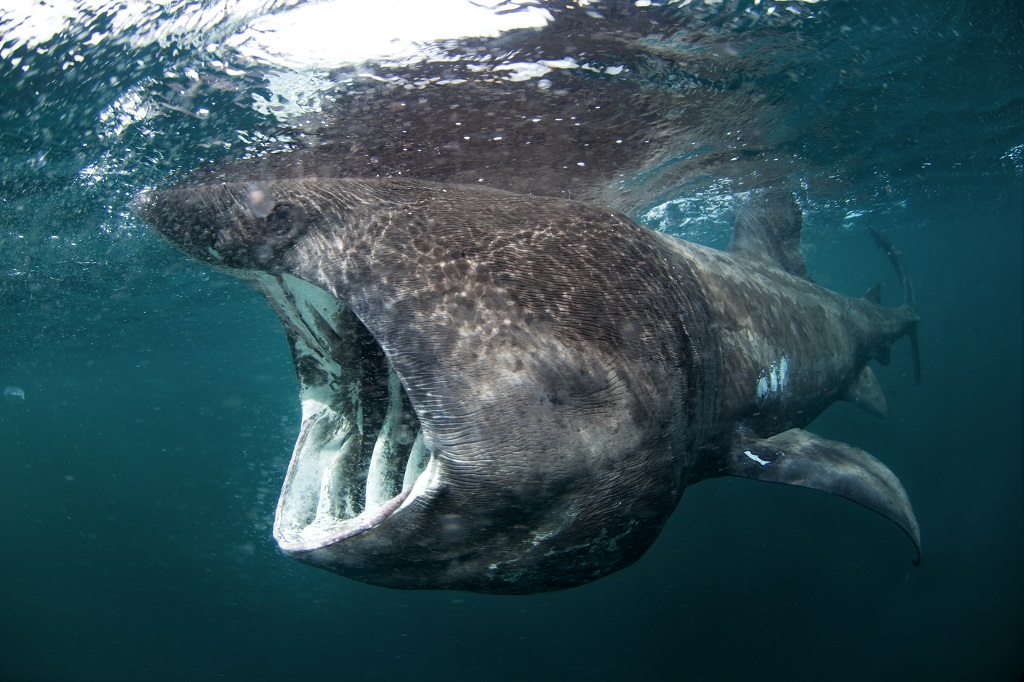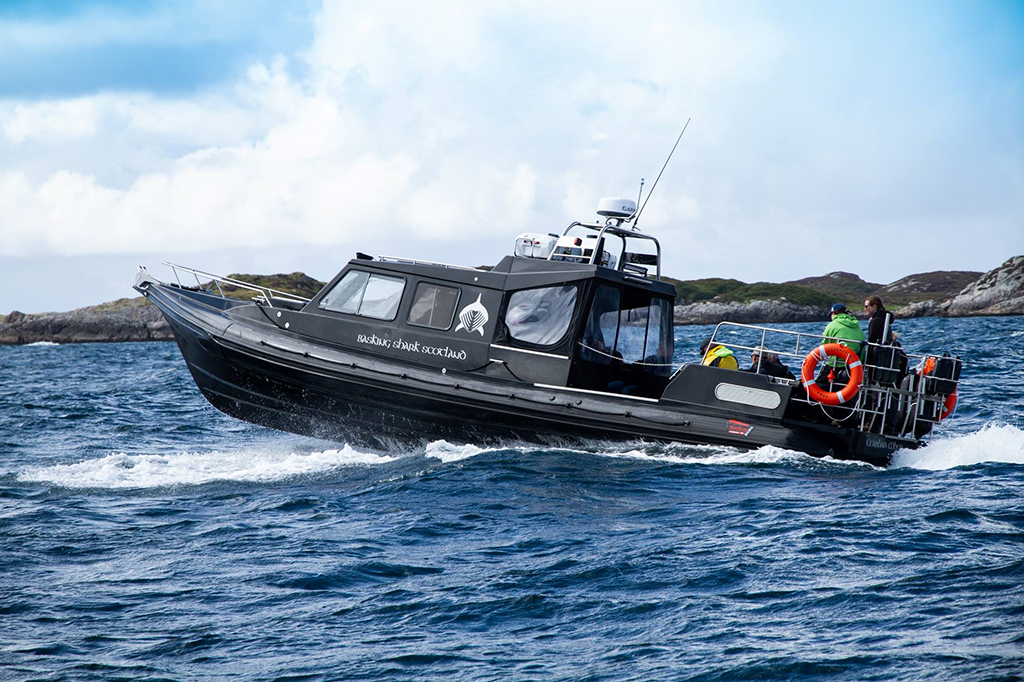With its gaping jaws and vicious glare, the basking shark looks a ferocious predator.
But this mysterious creature has no interest in human flesh and deserves its protected status in Scotland’s waters.
The basking shark has always been surrounded by myth. Shetland fishermen believed that the world’s second largest fish attached itself to the hulls of their boats to drag them under and drown all those on board.
Other coastal dwellers told tales of fabulous marine monsters and sea snakes of massively exaggerated proportions.
In 1906, for example, there were reports of a gigantic sea monster, 50 foot long, in Loch Broom, which was shot dead by the authorities. Even when monster theories were disproved, the tales continued.
These weird and wonderful beasts were usually basking sharks – known as brigda, muldoan, cearban, carfin, pricker, sunfish, homer or hoe mother in various parts of Scotland. It was not until 1796 that Thomas Pennant finally replaced the word sunfish, another species altogether, with basking shark.
The basking shark’s value was recognised very early on. Large carcasses, washed ashore, were quickly commandeered as blubber and bone was removed; valuable oil found in the shark’s massive liver was extracted for fuel for lamps. Compared to the oil from whales and seals, it burnt with less smoke and was used until replaced by petrol.
It was also frequently employed as medicine, and as a panacea for many ailments, especially rheumatism.

Sharks were hunted in a primitive fashion from the mid-1700s. Sometimes they would be caught up accidentally in other fishing activities, friendly giant something that is still a serious threat to them today.
The Statistical Account of 1790 reports the following from Loch Fyne: ‘This sluggish fish sometimes swims into the salmon nets, and suffers itself to be drawn towards the shore without any resistance, till it gets near the land that for want of a sufficient body of water, it cannot exert its strength, in disentangling itself from the net. The fishers in the mean time take advantage of the situation and attack it with sticks and stones till they have it secure.’
Doubtlessly this would have been an easier method of catching a shark. Small boats were badly equipped and the hunters were often injured as thrashing, wounded sharks battled for their lives. Harpoons were cruel and ineffectual, and prolonged death. Shark fisheries came and went on a small scale from the Sea of the Hebrides to the Firth of Clyde.
The first fishery survived until the 1830s, and then there was a lull in shark hunting. Anthony Watkins largely pioneered a modern basking shark fishery in Scotland, but Gavin Maxwell and Tex Geddes also set up the Isle of Soay Shark Fishery in 1944, hoping to provide enough income for themselves as well as work for the island community.
Maxwell had the enthusiasm, but his experience was woefully lacking. The venture was a fiasco fraught with failed equipment, breakdowns and weather-induced catastrophe. The final blow came when they discovered their hard-won shark livers had become flyblown in storage, rendering them unfit for sale. Maxwell lost heart; in any case he had begun to doubt the ethics of the pursuit.
The best outcome of his fishery was his linkup with two eminent zoologists, L Harrison Matthews and WW Parker, whom he had met while lecturing at the Linnean Society in London. He agreed that they could visit Soay to carry out valuable research on shark carcasses.
Matthews commented: ‘It was an enormous help to us to be able to use the machinery Gavin had installed for cutting up the sharks, because these creatures were not easy things to dissect – some of the organs were so big and heavy we could barely handle them, and if your scalpel slipped and you punctured the stomach, you could release half a ton of semidigested plankton all over your dissection.’
Sharks were fished in Scotland until 1994, when nine were taken by the last sharker, Howard McCrindle, who has since been working with researchers to protect sharks. Finally, in 1998, the basking shark received full legal protection under the Wildlife and Countryside Act.
When out of UK waters, it is still sought, its massive body discarded, its fins used to make soup for the East Asian market. Here, marine tourism remains a worrying threat – jet skis and speedboats can inflict fatal injuries to the sharks. An important marine code of conduct is now in force to protect them.

Basking sharks appeared frequently off Ardnamurchan when I was a child – some summers they were so abundant in the Sound of Mull, off Coll and Tiree and around the Small Isles, that when we fished for mackerel in a small boat we frequently puttered along close beside them.
Sometimes there was just one; on other occasions, many. They swam with their cavernous mouths agape. We watched as they soundlessly filtered vast amounts of seawater (up to 330,000 gallons an hour), filling their stomachs with a rich broth of plankton and minute marine life.
In the past decade, some of my best sightings have been around the Sound of Canna, and off Coll, areas of rich planktonic bloom. One morning, rising early on the boat I was crewing, there was an impressive shark close into the pier. The same day we came across a notably large shark off Ardnamurchan Point. As it slipped silently beneath the boat, we estimated it to be almost 30ft (9m) long. The following year, sightings were scant.
There have been few serious incidents as a result of direct contact with basking sharks. The best documented was the tragedy that occurred off Carradale in the Mull of Kintyre in 1937. Three people in a small boat lost their lives when a shark struck the boat and caused them to fall into the sea.
This incident was followed by an anti-shark campaign. Many basking sharks had been seen in the Firth of Clyde that summer; when other boats’ skippers claimed to have been attacked by a vast rogue shark, chasing after them, it blew the initial incident out of all proportion and led to further unsubstantiated stories of ‘shark attacks’. But these are slow-moving creatures, and any incidents were likely to have been purely accidental.
Nevertheless, divers have to remain mindful of the fact that sharks, like all wild creatures, are unreliable. Though they do not play in the same way as whales and dolphins, they can do so without warning, which is why it is unsafe to venture too close.
Until recently, little was known about these beasts that disappear to spend much time in the open ocean. They are thought to reach sexual maturity late and give birth to between one and six live young, measuring up to 2m in length.
There are still huge gaps in our knowledge of a creature that appears during a migratory surge. Unlike other migrations, though, the basking shark’s appears to be more fickle. Scottish Natural Heritage and Exeter University have begun an exciting new tagging project that will hopefully unveil valuable information on the sharks and their movements.
But it seems appropriate that an extraordinary creature that has intrigued and mystified us for so long should retain a few secrets at least.
- This feature was originally published in 2013.
TAGS

